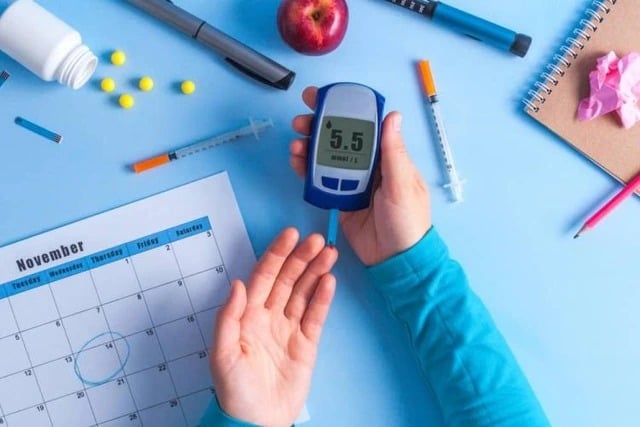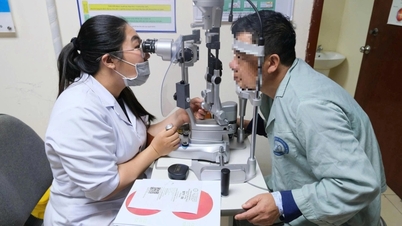According to experts, in Vietnam, about 1 in 13 people have diabetes. It is worth noting that currently, more than 60% of people with diabetes in Vietnam have not been diagnosed.
According to experts, in Vietnam, about 1 in 13 people have diabetes. It is worth noting that currently, more than 60% of people with diabetes in Vietnam have not been diagnosed.
November 14 was chosen by the International Diabetes Federation (IDF) as World Diabetes Day with the aim of raising awareness about this disease.
 |
| Illustration photo |
The theme of World Diabetes Day 2024 is “Know your risk to prevent the disease” which emphasizes the importance of understanding the risk of the disease, thereby taking timely preventive measures to maintain health.
According to IDF data, in 2021 the number of people with diabetes worldwide was 537 million. The number of people with the disease is expected to increase to 643 million by 2030 and to 783 million by 2045.
Statistics also show that over 70% of people with diabetes live in low- and middle-income countries due to the rapid increase in consumption of energy-rich foods and sedentary lifestyles.
The rate of obesity is increasing while the age of diabetes is getting younger. This is really an alarming problem.
According to a survey in Vietnam in 2020, the rate of diabetes is 7.3%, approximately 7 million people nationwide, meaning that about 1 in 13 people have diabetes, of which 55% of type 2 diabetes patients have cardiovascular, eye, nerve and kidney complications. Diabetic complications not only increase medical costs but also reduce quality of life.
A national survey by the Central Endocrinology Hospital (2002) showed that the rate of diabetes nationwide was 2.7%. After 10 years, this rate increased to 5.4%.
Of these, the rate of undiagnosed diabetes in Vietnam is currently more than 60% and more than half of adults have never had a blood sugar test to detect the disease.
Medical experts are concerned that the age of diabetes is getting younger, with some patients as young as 15-16 years old. The main causes are unhealthy diet, smoking, drinking a lot of beer and alcohol and lack of exercise.
If this disease is detected late and not treated promptly, it will often lead to dangerous complications in other parts of the body, significantly reducing the quality of life.
Another worrying fact is that this disease is getting younger and younger. Dr. Hoang Van Ket, Head of the Pediatric Intensive Care Department, Duc Giang General Hospital, said that diabetes in children is mainly type 1 diabetes, which is insulin-dependent diabetes.
Type 1 diabetes (also known as type 1 diabetes) is a medical condition that occurs when the pancreas does not produce or produces very little insulin, leading to a severe endogenous insulin deficiency.
The disease is usually diagnosed in children and young adults. The disease can start from a few months of age, the most common age is 10-14 years. The male/female ratio is equal. Type 1 diabetes accounts for about 5-10% of people with diabetes.
The cause of type 1 diabetes is 95% due to autoimmune mechanism and 5% of cases are unknown. The immune system mistakenly attacks and destroys cells responsible for producing insulin in the pancreas.
Some risk factors such as infection with Coxsackie virus, Rubella, Cytomegalovirus... or early dietary exposure to cow's milk are also related to the onset of the disease.
Certain anti-pancreatic beta-cell antibodies can also be found in the majority of patients with type 1 diabetes.
In addition, many people previously mistakenly thought that type 1 diabetes was a genetic disease, which is not true. Type 1 diabetes is not classified as a genetic disorder.
However, a person is more likely to develop type 1 diabetes if a first-degree relative such as a parent or sibling has the disease.
Therefore, when symptoms such as thirst, drinking a lot, urinating a lot, weight loss, fatigue, blurred vision, new bedwetting appear in children who have not had it before.
In particular, when accompanied by some dangerous warning symptoms of type 1 diabetes such as abdominal pain, vomiting, impaired consciousness, rapid deep breathing, breath smelling of ripe fruit (ripe apples...), the patient must be taken immediately to a medical facility for examination, diagnosis and timely treatment.
Currently, insulin is still required to treat type 1 diabetes. Early insulin use also helps preserve remaining beta cell function. Good blood sugar control helps reduce the risk of long-term complications.
In addition, patients must also adjust their diet and lifestyle to suit each individual. For people with moderate physical activity, they should maintain about 30-35 calories/kg/day.
Balancing the ratios of carbohydrates, proteins, and lipids helps control blood sugar but also ensures the patient's daily activities.
Especially in children, in addition to controlling blood sugar, it is also necessary to ensure the child's normal growth and development goals. People with type 1 diabetes should monitor their blood sugar at least 4 times a day to be able to adjust insulin dosage based on blood sugar at home.
Source: https://baodautu.vn/bao-dong-ty-le-mac-benh-dai-thao-duong-o-nguoi-viet-d230000.html








































































































Comment (0)